Energy 78 kJ (19 kcal) Sugars 1.8 g Fat 0.14 g | Carbohydrates 4.3 g Dietary fiber 2.9 g Protein 0.9 g | |
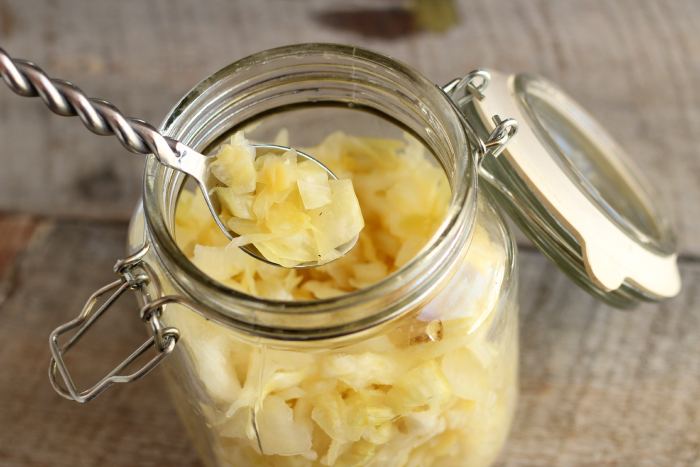 | ||
Similar | ||
Sauerkraut (/ˈsaʊərkraʊt/; [ˈzaʊ.ɐˌkʁaʊt]) is finely cut cabbage that has been fermented by various lactic acid bacteria, including Leuconostoc, Lactobacillus, and Pediococcus. It has a long shelf life and a distinctive sour flavor, both of which result from the lactic acid that forms when the bacteria ferment the sugars in the cabbage.
Contents
- How to make sauerkraut p allen smith cooking classics
- Overview
- Production
- Regional varieties
- Benefits
- Disadvantages
- Similar foods
- References
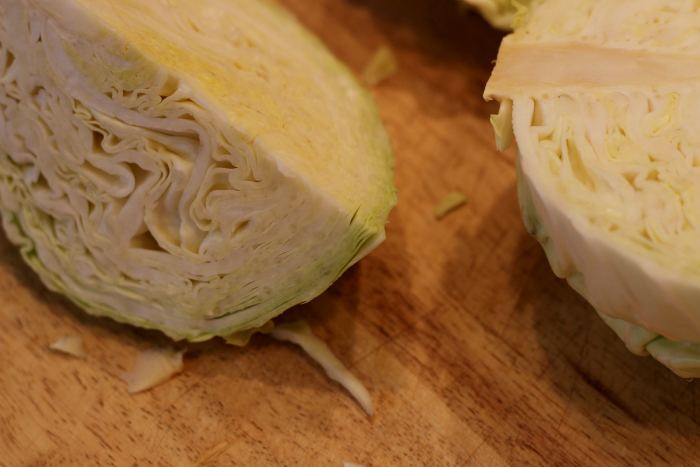
How to make sauerkraut p allen smith cooking classics
Overview
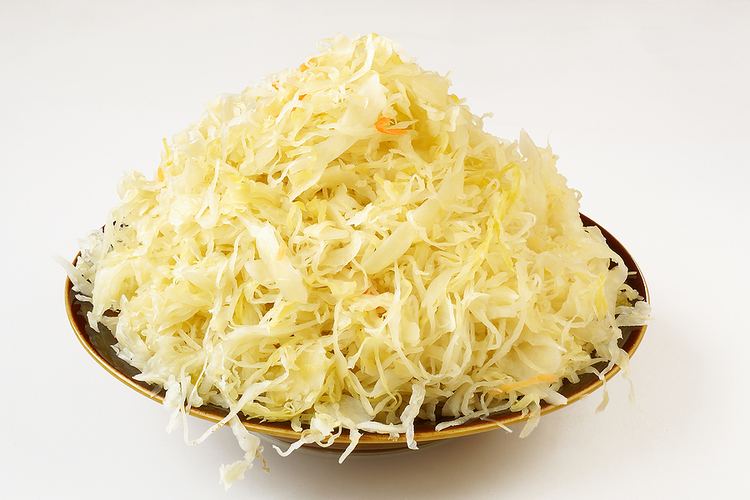
Fermented foods have a long history in many cultures, with sauerkraut being one of the most well-known instances of traditional fermented moist cabbage side dishes. The Roman writers Cato (in his De Agri Cultura) and Columella (in his De re Rustica) mentioned preserving cabbages and turnips with salt.
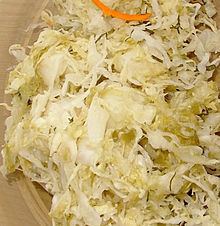
Sauerkraut took root mostly in Eastern European and Germanic cuisines, but also in other countries including the Netherlands, where it is known as zuurkool, and France, where the name became choucroute. The English name is borrowed from German where it means literally "sour herb" or "sour cabbage". The names in Slavic and other East European languages have similar meanings with the German word: "fermented cabbage" (Belarusian: квашаная капуста, Czech: kysané zelí, Polish: kiszona kapusta or kwaszona kapusta, Lithuanian: rauginti kopūstai, Russian: квашеная капуста, tr. kvashenaya kapusta, Ukrainian: квашена капуста) or "sour cabbage" (Bulgarian: кисело зеле, Croatian: kiseli kupus, Czech: kyselé zelí, Hungarian: savanyúkáposzta, Latvian: skābēti kāposti, Romanian: varză murată, Russian: кислая капуста, tr. kislaya kapusta, Serbian: kiseli kupus, Slovak: kyslá kapusta, Slovene: kislo zelje, Ukrainian: кисла капуста, Estonian: hapukapsas).
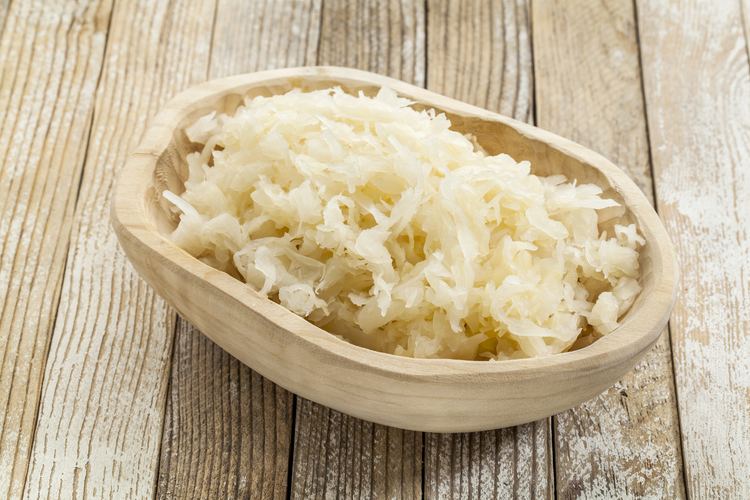
Before frozen foods, refrigeration, and cheap transport from warmer areas became readily available in northern, central and eastern Europe, sauerkraut, like other preserved foods, provided a source of nutrients during the winter. James Cook always took a store of sauerkraut on his sea voyages, since experience had taught him it prevented scurvy.
During World War I, due to concerns the American public would reject a product with a German name, American sauerkraut makers relabeled their product as "Liberty cabbage" for the duration of the war.
During World War I, British and Commonwealth forces used the word Kraut, derived from the dish, as a derogatory term for the German people. During World War II, the term was picked up by American forces.
Production
Sauerkraut is made by a process of pickling called lactic acid fermentation that is analogous to how traditional (not heat-treated) pickled cucumbers and kimchi are made. The cabbage is finely shredded, layered with salt, and left to ferment. Fully cured sauerkraut keeps for several months in an airtight container stored at 15 °C (60 °F) or below. Neither refrigeration nor pasteurization is required, although these treatments prolong storage life.
Fermentation by lactobacilli is introduced naturally, as these air-borne bacteria culture on raw cabbage leaves where they grow. Yeasts also are present, and may yield soft sauerkraut of poor flavor when the fermentation temperature is too high. The fermentation process has three phases, collectively sometimes referred to as population dynamics. In the first phase, anaerobic bacteria such as Klebsiella and Enterobacter lead the fermentation, and begin producing an acidic environment that favors later bacteria. The second phase starts as the acid levels become too high for many bacteria, and Leuconostoc mesenteroides and other Leuconostoc spp. take dominance. In the third phase, various Lactobacillus species, including L. brevis and L. plantarum, ferment any remaining sugars, further lowering the pH. Properly cured sauerkraut is sufficiently acidic to prevent a favorable environment for the growth of Clostridium botulinum, the toxins of which cause botulism.
A 2004 genomic study found an unexpectedly large diversity of lactic acid bacteria in sauerkraut, and that previous studies had oversimplified this diversity. Weissella was found to be a major organism in the initial, heterofermentative stage, up to day 7. It was also found that Lactobacillus brevis and Pediococcus pentosaceus had smaller population numbers in the first 14 days than previous studies had reported.
The Dutch sauerkraut industry found that inoculating a new batch of sauerkraut with an old batch resulted in an excessively sour product. This sourdough process is known as "backslopping" or "inoculum enrichment"; when used in making sauerkraut, first- and second-stage population dynamics, important to developing flavor, are bypassed. This is due primarily to the greater initial activity of species L. plantarum.
Regional varieties
In Belarusian, Polish, Russian, Baltic country and Ukrainian cuisine, chopped cabbage is often pickled together with shredded carrots. Other ingredients may include whole or quartered apples for additional flavor or cranberry for flavor and better keeping (the benzoic acid in cranberries is a common preservative). Bell peppers also known to be added as they improve the looks of the completed dish. The resulting sauerkraut salad is typically served cold, as a zakuski or a side dish. There is also a home made type of very mild sauerkraut where white cabbage is pickled with salt in a refrigerator for only between three and seven days. This results in very little lactic acid being produced. Typically wider strips of 1 to 2 centimeters (1") are used rather than the shredded cabbage used for traditional sauerkraut. This type is popular when eaten with zakuski.
Sauerkraut may be used as a filling for Polish pierogi, Ukrainian varenyky, Russian pirogi and pirozhki. Sauerkraut is also the central ingredient in traditional soups, such as shchi (a national dish of Russia), kwaśnica (Poland), kapustnica (Slovakia), and zelňačka (Czech Republic). It is a common ingredient of Polish bigos (a hunter's stew).
In Germany, cooked sauerkraut is often flavored with juniper berries or caraway seeds; apples and white wine are added in popular variations. Traditionally it is served warm, with pork (e.g. eisbein, schweinshaxe, Kassler) or sausages (smoked or fried sausages, Frankfurter Würstchen, Vienna sausages, black pudding), accompanied typically by roasted or steamed potatoes or dumplings (knödel or schupfnudel). Similar recipes are common in other Central European cuisines. The Czech national dish vepřo knedlo zelo consists of roast pork with knedliky and sauerkraut.
In France, sauerkraut is the main ingredient of the Alsatian meal choucroute garnie (French for "dressed sauerkraut"), sauerkraut with sausages (Strasbourg sausages, smoked Morteau or Montbéliard sausages), charcuterie (bacon, ham, etc.), and often potatoes. Usually it is cooked with Alsatian white wines.
Sauerkraut, along with pork, is eaten traditionally in Pennsylvania on New Year's Day. The tradition, started by the Pennsylvania Dutch, is thought to bring good luck for the upcoming year. Sauerkraut is also used in American cuisine as a condiment upon various foods, such as sandwiches and hot dogs.
Benefits
Many health benefits have been claimed for sauerkraut.
Disadvantages
Excessive consumption of sauerkraut may lead to bloating and flatulence due to the trisaccharide raffinose, which the human small intestine cannot break down.
Similar foods
Many other vegetables are preserved by a similar process:
